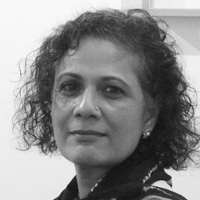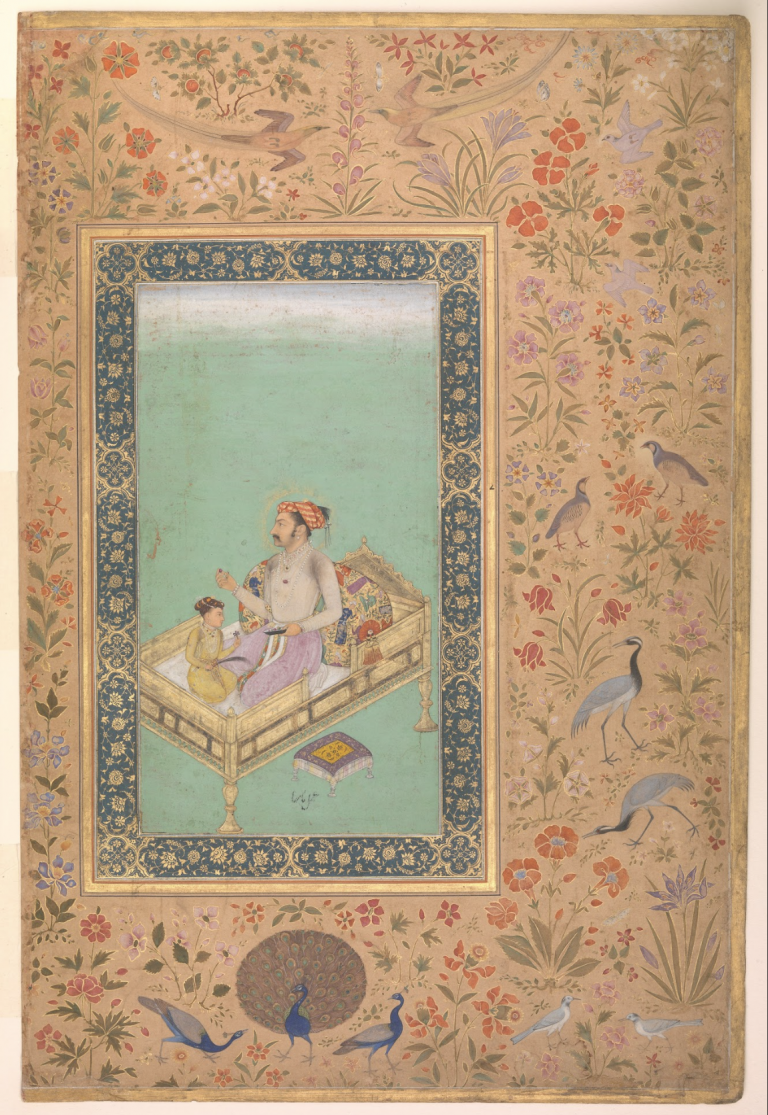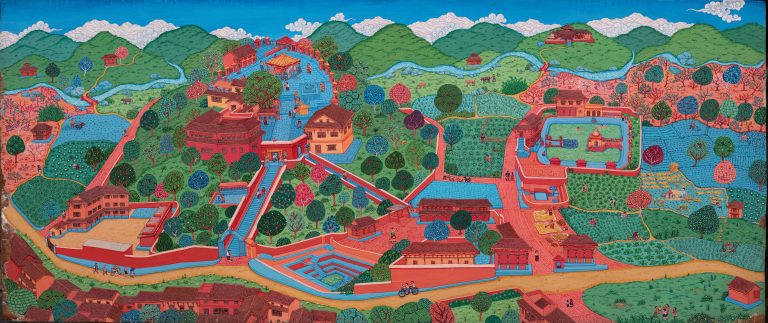I walked into the newly renovated Ashna Gallery [previously Viart] on a hot April afternoon to a sparse offering by Shivani Aggarwal, of her recent works ‘Close Knit’. The painted photographs in off white, greys and whites with minimal use of red are neither comforting nor alienating. In fact the problem is that they do not engage you for their own sake but in their apparent incompleteness compel you question.
Shivani not only paints and photographs the textiles portrayed in her work, but creates some of them to further work with. In Pin-Cushion, the crochet piece held by fingers pointing at us, has been constructed by the artist and I wondered why she does not make the textile rather than paint or photograph it, but this is how she draws your interest and reveals that she is not concerned about making the fabric, but uses the process of construction and de-construction, where threads entangle, support, entwine, loop and sometimes fall apart, as references for those thoughts that occupy us in the relationships we engage with. The fact that she uses textile as the metaphor with which to elucidate this point is insightful, for etymologically textiles refer to the main body and defining this beyond the physical form, is essentially done through relationships

Living in the urban metropolis of New Delhi, Shivani is as much a part of its cacophonic frenzies as the rest us. This is what she seems to address through the relationships she encounters that reflect its morals and ethics or lack of, not in presenting their physical reality but disassociating from this altogether. The emotion seems to compel her expression more than the physical dimension of these relationships, implying that it is not a singular association, but a general state of being that is articulated. While the works are not entirely abstract, for she presents some physical attributes through threads, fabrics, implements and partial representation of the human body, they are not rooted in any physical space or context.
In a large untitled work that occupies a whole wall; on its pale ground Shivani places a potli (knotted bag) of white fabric containing some unruly red coloured threads, above this, a semi-knitted red fabric hangs from apparently nowhere and on the right of the bundle, at a lower level, lie a pair of bent knitting needles that have miraculously knitted a few lines, again in red. The use of Red is evocative of strong emotions. Trying to contain unruly threads in a stark white bundle is a challenging endeavour. The bundle has been tied with ease; aside from a few threads that peep out of the ties, there is no sign of a struggle in containing them. While Shivani says that the works exhibited through ‘Close Knit’ are formed as a result of contemplation to understand, analyze and resolve thoughts and situations, this is not visually explored or presented in a way that displays any characteristics of the resolution of emotions. The implication therefore is not of dealing with the feeling and therefore containing it through a detached stance, but suppressing or controlling it and even so the bundle is too neat to convey this either. Can unruly thoughts ever be contained?
At the opposite end of the emotional spectrum, the colour white is predominant in the lace or crochet work. In Lace 1, we see a series of six works where a body sews white lace onto itself, with red thread. The lace is readymade. Lace is intended as a metaphor for social affability and adornment, where regardless of the way you feel, this must be not be displayed when interacting in the social arena. The use of white here is not particularly evocative. As in the other works, there is an apparent hesitation to speak freely of the struggle in dealing with complex emotions or of the discomfort in suppressing them. She paints knitting needles, pins and cutters to express the process of construction and deconstruction, yet the cutters don’t cut, needles don’t knit and pins appear to puncture the skin only superficially. The inference drawn is that the artist speaks of either not being able to inflict pain, pierce right through the skin/surface of the body or relationship or that somehow, the idea or person is disabled from doing so.
All the works on display are very orderly and neatly painted; everything is carefully controlled, even at its most chaotic. The artist’s comfort level in textile making is clearly not enough to induce a creative presentation of her experience and therefore she resorts to using it as a metaphor, while photography and painting allow a certain comfort in representation. Given the underlying meaning of a desire to contain rather than inflict pain, this may however have been a useful endeavour. Engaging with the repetitive, almost chant-like, painstaking mechanics and tactile materiality of knitting or crochet would absorb and diffuse the intensity of emotion, calming like a mantra, thereby achieving a certain sense of detachment, but sublimation without excoriation does not appear to be the intent either.
The work is subtle and does not have the visceral appeal of much of today’s art but sensitively leads deeper, questioning the very act of creation. Should this be about creating a more wholesome and fulfilling life, where the artistic practice becomes a means to resolve feelings/emotion and move beyond them? Or is it about creating for the sake of play, to nuance age-old dilemmas in a novel way. Which element of creativity should be valued, the artistic practice or human evolution? This point of view or any other is not clearly articulated and like the bent needles that can barely knit or pins that don’t prick, Shivani leaves us intrigued but is unable to convey what she feels.
Close Knit, Shivani Aggarwal, 21 April-15 May 2010, Ashna Gallery, New Delhi













